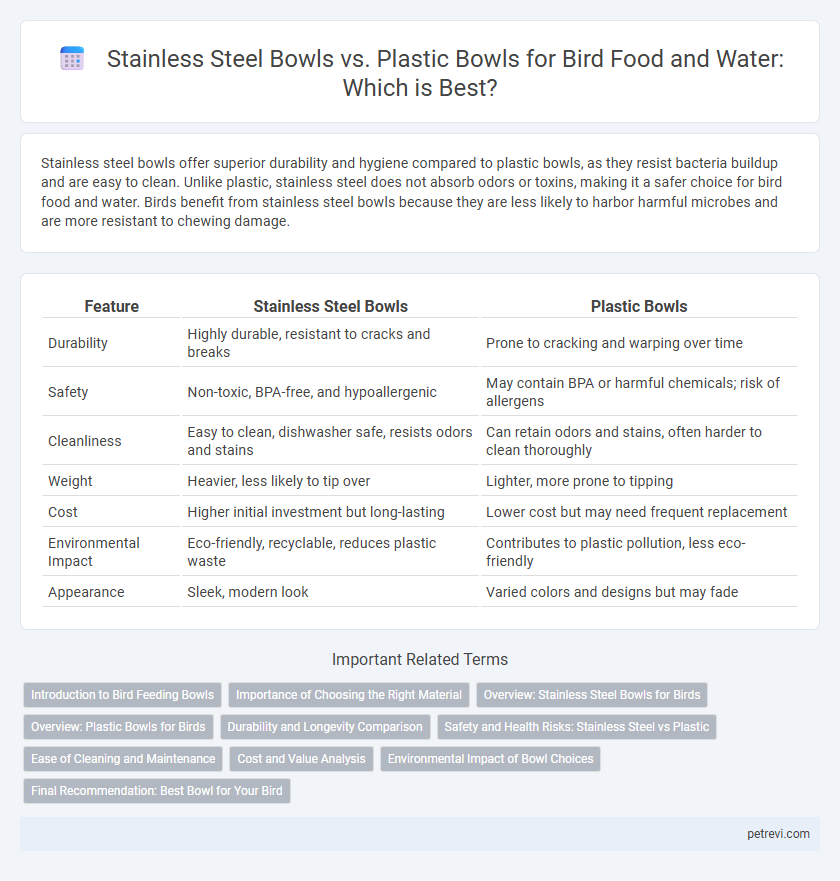Stainless steel bowls offer superior durability and hygiene compared to plastic bowls, as they resist bacteria buildup and are easy to clean. Unlike plastic, stainless steel does not absorb odors or toxins, making it a safer choice for bird food and water. Birds benefit from stainless steel bowls because they are less likely to harbor harmful microbes and are more resistant to chewing damage.
Table of Comparison
| Feature | Stainless Steel Bowls | Plastic Bowls |
|---|---|---|
| Durability | Highly durable, resistant to cracks and breaks | Prone to cracking and warping over time |
| Safety | Non-toxic, BPA-free, and hypoallergenic | May contain BPA or harmful chemicals; risk of allergens |
| Cleanliness | Easy to clean, dishwasher safe, resists odors and stains | Can retain odors and stains, often harder to clean thoroughly |
| Weight | Heavier, less likely to tip over | Lighter, more prone to tipping |
| Cost | Higher initial investment but long-lasting | Lower cost but may need frequent replacement |
| Environmental Impact | Eco-friendly, recyclable, reduces plastic waste | Contributes to plastic pollution, less eco-friendly |
| Appearance | Sleek, modern look | Varied colors and designs but may fade |
Introduction to Bird Feeding Bowls
Stainless steel bowls for bird feeding offer durability and resistance to bacteria, ensuring a hygienic eating environment for birds. Plastic bowls are lightweight and inexpensive but can harbor scratches where harmful microbes thrive, potentially affecting bird health. Choosing stainless steel bowls promotes cleanliness and longevity, making them a preferred option for bird food and water containers.
Importance of Choosing the Right Material
Stainless steel bowls provide superior durability and resistance to bacterial growth, making them a safer choice for bird food and water compared to plastic bowls. Plastic bowls can harbor scratches that trap bacteria and release harmful chemicals over time, potentially affecting bird health. Selecting stainless steel ensures long-lasting hygiene and maintains the freshness of food and water, crucial for a bird's well-being.
Overview: Stainless Steel Bowls for Birds
Stainless steel bowls for birds offer superior durability and hygiene compared to plastic bowls, resisting scratches and bacterial buildup. Their non-porous surface prevents absorption of odors and contaminants, ensuring a safer feeding environment. These bowls are also easier to clean and dishwasher safe, promoting overall bird health and longevity.
Overview: Plastic Bowls for Birds
Plastic bowls for bird food and water are lightweight, affordable, and available in a wide range of colors and sizes, making them a popular choice for many bird owners. They are less durable than stainless steel, prone to scratches and potential bacterial buildup if not cleaned frequently and thoroughly. Despite the convenience, plastic bowls can contain harmful chemicals like BPA, which may pose health risks to birds over time.
Durability and Longevity Comparison
Stainless steel bowls for bird food and water offer superior durability compared to plastic bowls, resisting cracks, chips, and stains that commonly degrade plastics over time. Their longevity is enhanced by corrosion resistance and ease of cleaning, ensuring a hygienic feeding environment that withstands frequent washing and exposure to bird activity. Plastic bowls often wear out faster due to surface scratches and potential chemical absorption, which can affect both the health of birds and the maintenance cycle of feeders.
Safety and Health Risks: Stainless Steel vs Plastic
Stainless steel bowls provide a safer and more hygienic option for bird food and water due to their non-porous surface, which resists bacteria buildup and prevents chemical leaching. Plastic bowls can harbor harmful pathogens in scratches and may release toxic substances like BPA or phthalates, posing health risks to birds. Choosing stainless steel significantly reduces exposure to contaminants, promoting better bird health and longevity.
Ease of Cleaning and Maintenance
Stainless steel bowls offer superior ease of cleaning and maintenance compared to plastic bowls, as they are non-porous and resist bacteria buildup, reducing the risk of contamination for birds. Unlike plastic, stainless steel does not retain odors or stains and can withstand frequent sterilization in dishwashers without degrading. This durability ensures a hygienic feeding environment, promoting better health for pet birds.
Cost and Value Analysis
Stainless steel bowls for bird food and water offer greater durability and long-term cost savings compared to plastic bowls, which tend to crack and degrade over time. While plastic bowls are initially cheaper, frequent replacements increase overall expenses and risk exposure to harmful chemicals. Stainless steel bowls provide better value through enhanced hygiene, resistance to bacterial buildup, and minimal maintenance requirements.
Environmental Impact of Bowl Choices
Stainless steel bowls are eco-friendly due to their durability and recyclability, minimizing waste over time compared to plastic bowls, which contribute to environmental pollution through non-biodegradable waste and chemical leaching. Plastic bowls often require frequent replacement, increasing landfill contributions and microplastic contamination, whereas stainless steel can last for years without degrading environmental quality. Choosing stainless steel supports sustainable bird care by reducing plastic waste and harmful environmental impacts associated with petroleum-based products.
Final Recommendation: Best Bowl for Your Bird
Stainless steel bowls offer durability, resistance to bacteria, and ease of cleaning, making them the superior choice for bird food and water. Plastic bowls, while lightweight and inexpensive, can harbor bacteria and are prone to scratches that compromise hygiene. For optimal bird health and safety, stainless steel bowls are the best investment.
Stainless steel bowls vs Plastic bowls for Bird food/water Infographic

 petrevi.com
petrevi.com